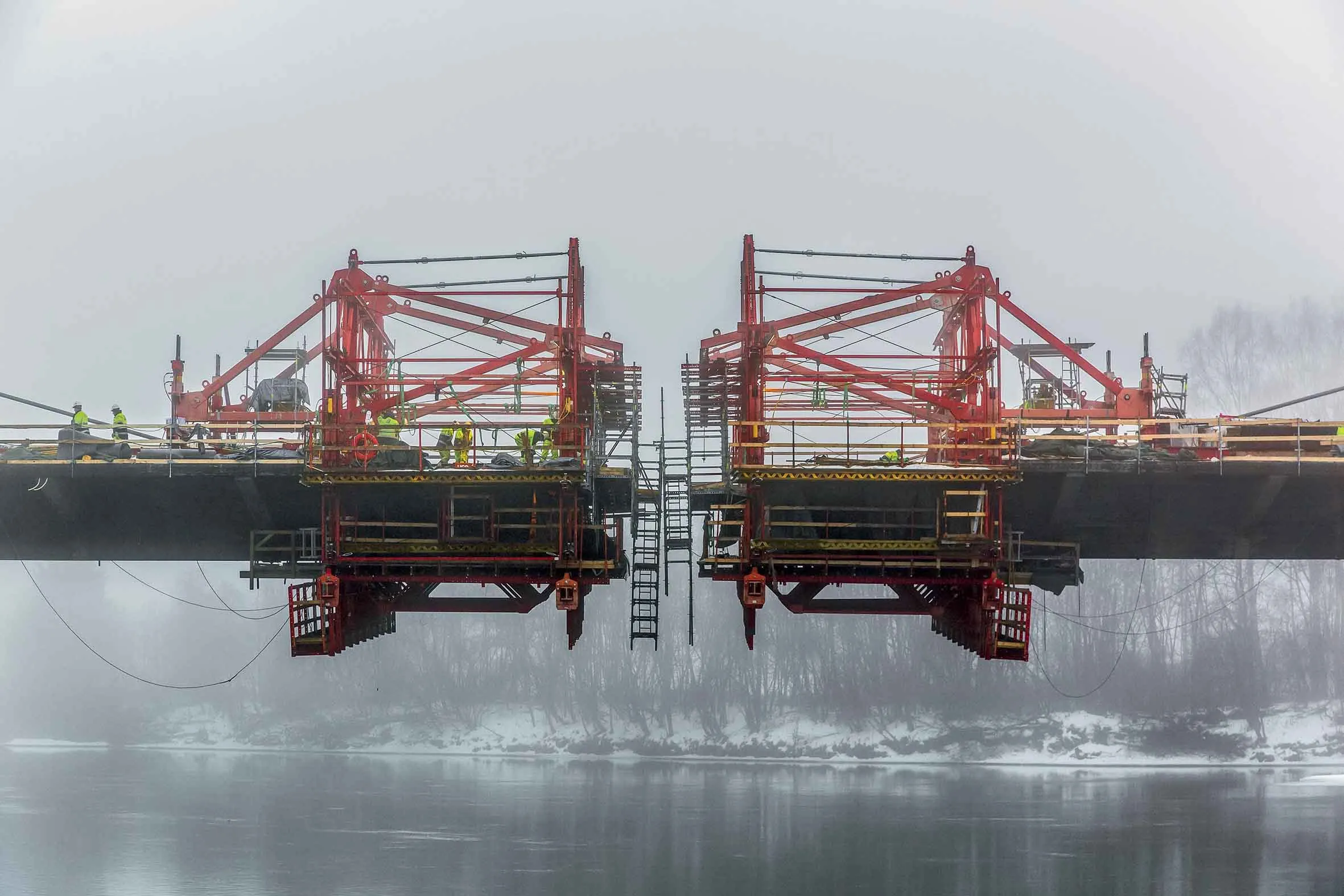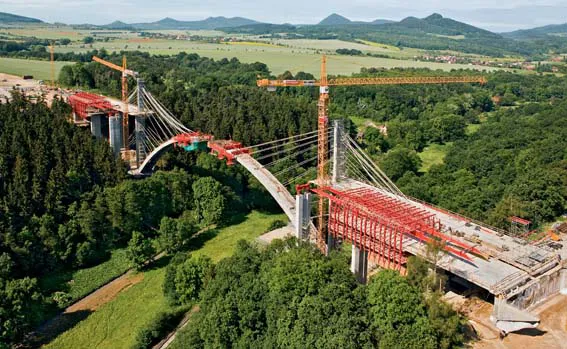Plans for the European Route E6 expansion in Norway include the 320m-long Harpe Bru Bridge over the Gudbrandsdalen Lågen River, at Sør-Fron in Oppland province.
For the superstructure, PERI civil engineering technology experts developed a balanced cantilevered solution based on the VARIOKIT Engineering Construction Kit.
Statens vegvesen, Norway’s agency for public road building, selected an extradosed cable-stayed bridge design – the first such bridge in Norway. It combines the load-bearing behaviour
May 24, 2016
Read time: 4 mins

Plans for the European Route E6 expansion in Norway include the 320m-long Harpe Bru Bridge over the Gudbrandsdalen Lågen River, at Sør-Fron in Oppland province.
For the superstructure,298 PERI civil engineering technology experts developed a balanced cantilevered solution based on the VARIOKIT Engineering Construction Kit.
1208 Statens vegvesen, Norway’s agency for public road building, selected an extradosed cable-stayed bridge design – the first such bridge in Norway. It combines the load-bearing behaviour of a cable-stayed bridge with that of a girder bridge whereby the tendons are positioned outside the bridge cross-section.
As a result, the overall height of the superstructure as well as the height of the pylons can be kept relatively low. The slightly inclined stay cables support the superstructure and simultaneously tension it.
The largest section of the bridge is around 100m and positioned over the middle of the river between the two pylons. On land, two additional piers along with the abutments have been arranged.
The Polish subsidiary of the Porr Group was commissioned for construction of the bridge and worked closely with PERI engineers in Poland. The PERI Balanced Cantilever Equipment is based on standard components taken from the VARIOKIT Engineering Construction Kit. These are readily available in PERI rental parks, meaning they were delivered at short notice and under favourable terms to the main contractor.
Primary challenges for the implementation of balanced cantilever formwork are the geometric cross-sectional changes of the superstructure and the varying, in part, very high loads. In addition, the cross-section of Harpe Bru superstructure required transverse ribs between the lateral cantilever of the carriageway slab and the hollow box girders.
Furthermore, the engineers had to consider the cables used for the suspension by which the segments are attached to the pylons. At no time during the execution were they allowed to collide with the Balanced Cantilever Carriage.
Planning of a balanced cantilever solution automatically involved high static requirements. As a result, constantly changing load conditions led to varying stresses and deformations. These had to be considered regarding the dimensional accuracy of concreting.
The VARIOKIT solution for the cantilevered construction is a combination of heavy box girders for the load transfer and VARIOKIT standard components for forming formwork, working scaffolds and platforms. Due to the steel structure for the longitudinal direction of the PERI Balanced Cantilevered Carriage, up to 5.75m-long segments could be concreted.
For the Harpe Bru, four Balanced Cantilever Carriages are in use with which 5.55m-long segments are constructed. The bottom slab with the side walls along with the outer ribs of the hollow box girders are concreted first. For this, compact DOMINO Panel Formwork Elements as well as project-specific VARIO GT 24 Formwork Elements were used.
The integrated formwork for the 1.3m high transverse ribs was also based on the VARIO Girder Wall Formwork in which spindling can take place quickly and easily during striking.
In a second concreting section for each segment, the carriageway slab was then concreted.
The PERI formwork solution ensures exact and dimensionally accurate concreting. In addition, the independent moving procedure results in optimised execution times thanks to the integrated hydraulics together with the fully hydraulically-operable aligning and adjusting.
The PERI solution helped keep workloads for each bridge segment as low as possible. This has had a measurable impact on the construction time. Also, the Balanced Cantilever Carriage can be combined with the PERI UP Modular Scaffolding to ensure safe work spaces and access to all working areas. Scaffold can be connected with the VARIOKIT standard components using simple connecting means to form safe working platforms and access points.
European Route E6 in Norway
The European Route 6 (E6) stretches 3,140km from the southern Swedish town of Trelleborg through to Norway. It then runs through almost all of the country to Finnmark to connect Norway with the west coast of Sweden. Several projects for the expansion of the European Route are in planning or being under construction. This includes widening to four lanes the route from Ostfold to the Swedish border at Svines, as well as construction of several bridges, including the Harpe Bru.
For the superstructure,
As a result, the overall height of the superstructure as well as the height of the pylons can be kept relatively low. The slightly inclined stay cables support the superstructure and simultaneously tension it.
The largest section of the bridge is around 100m and positioned over the middle of the river between the two pylons. On land, two additional piers along with the abutments have been arranged.
The Polish subsidiary of the Porr Group was commissioned for construction of the bridge and worked closely with PERI engineers in Poland. The PERI Balanced Cantilever Equipment is based on standard components taken from the VARIOKIT Engineering Construction Kit. These are readily available in PERI rental parks, meaning they were delivered at short notice and under favourable terms to the main contractor.
Primary challenges for the implementation of balanced cantilever formwork are the geometric cross-sectional changes of the superstructure and the varying, in part, very high loads. In addition, the cross-section of Harpe Bru superstructure required transverse ribs between the lateral cantilever of the carriageway slab and the hollow box girders.
Furthermore, the engineers had to consider the cables used for the suspension by which the segments are attached to the pylons. At no time during the execution were they allowed to collide with the Balanced Cantilever Carriage.
Planning of a balanced cantilever solution automatically involved high static requirements. As a result, constantly changing load conditions led to varying stresses and deformations. These had to be considered regarding the dimensional accuracy of concreting.
The VARIOKIT solution for the cantilevered construction is a combination of heavy box girders for the load transfer and VARIOKIT standard components for forming formwork, working scaffolds and platforms. Due to the steel structure for the longitudinal direction of the PERI Balanced Cantilevered Carriage, up to 5.75m-long segments could be concreted.
For the Harpe Bru, four Balanced Cantilever Carriages are in use with which 5.55m-long segments are constructed. The bottom slab with the side walls along with the outer ribs of the hollow box girders are concreted first. For this, compact DOMINO Panel Formwork Elements as well as project-specific VARIO GT 24 Formwork Elements were used.
The integrated formwork for the 1.3m high transverse ribs was also based on the VARIO Girder Wall Formwork in which spindling can take place quickly and easily during striking.
In a second concreting section for each segment, the carriageway slab was then concreted.
The PERI formwork solution ensures exact and dimensionally accurate concreting. In addition, the independent moving procedure results in optimised execution times thanks to the integrated hydraulics together with the fully hydraulically-operable aligning and adjusting.
The PERI solution helped keep workloads for each bridge segment as low as possible. This has had a measurable impact on the construction time. Also, the Balanced Cantilever Carriage can be combined with the PERI UP Modular Scaffolding to ensure safe work spaces and access to all working areas. Scaffold can be connected with the VARIOKIT standard components using simple connecting means to form safe working platforms and access points.
European Route E6 in Norway
The European Route 6 (E6) stretches 3,140km from the southern Swedish town of Trelleborg through to Norway. It then runs through almost all of the country to Finnmark to connect Norway with the west coast of Sweden. Several projects for the expansion of the European Route are in planning or being under construction. This includes widening to four lanes the route from Ostfold to the Swedish border at Svines, as well as construction of several bridges, including the Harpe Bru.









